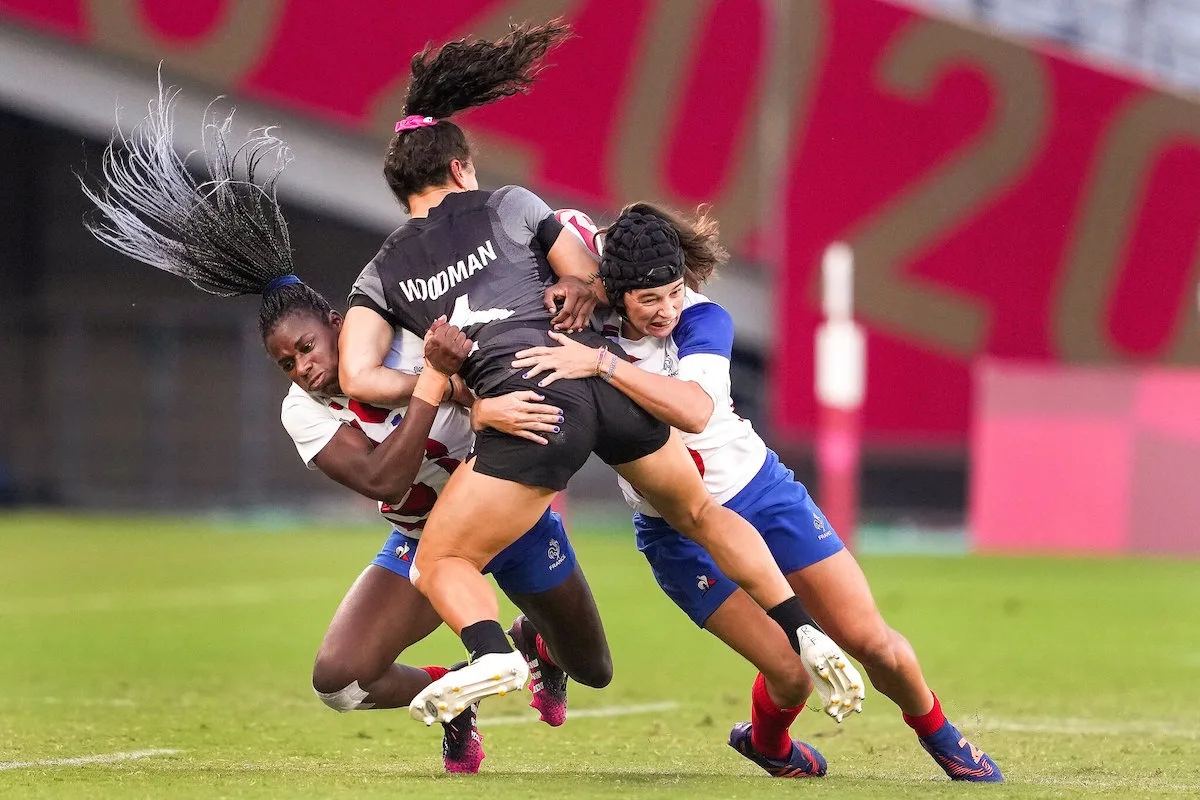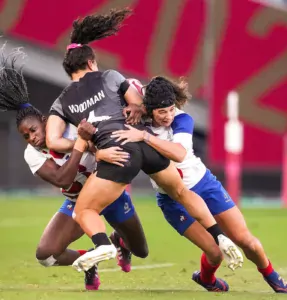In the pulsating world of rugby, tackling is an art form, a vital aspect that can make or break a game. When it comes to tackling techniques, two primary approaches stand out: the dominant tackle and the passive tackle. These contrasting methods play a pivotal role in determining the course of a match. In this comprehensive exploration, we will delve deep into the intricate details of dominant and passive tackles, deciphering their nuances and understanding when and how to employ them on the rugby field.
Understanding the Essence of Rugby Tackling
Before we dive into the specifics of dominant and passive tackles, it is essential to establish a fundamental understanding of tackling in rugby. Tackling, in its core, is the act of stopping an opponent who is carrying the ball, thereby preventing them from advancing further down the field. It’s a defensive maneuver designed to regain possession of the ball or at the very least, slow down the attacking team’s progress.
Tackling in rugby is a high-stakes endeavor, demanding impeccable timing, technique, and a strong mindset. It is often said that the game is won or lost in the tackle, making it a critical aspect of both offensive and defensive strategies.
The Dominant Tackle: Imposing Authority
The Power of Dominance
The dominant tackle is aptly named for its aggressive and authoritative nature. In this style of tackling, the defender seeks to impose their will upon the ball carrier. It involves making a strong, forceful contact with the opponent, with the intention of not only stopping their forward progress but also dislodging the ball from their possession.
Key Characteristics of a Dominant Tackle
- Physicality: Dominant tackles are characterized by their physicality. The defender aggressively approaches the ball carrier and delivers a powerful hit, often involving a shoulder charge.
- Intent to Dispossess: One of the primary objectives of a dominant tackle is to dispossess the ball carrier. Defenders aim to create turnovers by forcing the ball loose or causing a knock-on.
- Impactful: Dominant tackles are typically crowd-pleasers due to their ferocity and impact. They can swing momentum in favor of the defending team and energize the players and fans alike.
When to Use Dominant Tackles
- In Open Field: Dominant tackles are highly effective when executed in open field situations, where there is ample space for the defender to build up momentum.
- Against Skillful Ball Carriers: When facing skillful and elusive ball carriers, opting for a dominant tackle can disrupt their rhythm and force errors.
- Near the Sideline: When near the sideline, a dominant tackle can be strategically employed to push the ball carrier out of bounds, resulting in a lineout.
The Passive Tackle: Control and Containment
Embracing Containment
Unlike the assertive approach of the dominant tackle, the passive tackle focuses on control and containment. This tackling style aims to limit the ball carrier’s progress while maintaining defensive structure and minimizing the risk of penalties.
Key Characteristics of a Passive Tackle
- Wrap and Secure: In a passive tackle, the defender wraps their arms around the ball carrier, seeking to secure and contain them. It’s a more controlled, less aggressive approach.
- Minimized Risk: Passive tackles reduce the risk of high tackles, shoulder charges, or other dangerous play that could result in penalties or yellow cards.
- Team Effort: Passive tackles often involve multiple defenders working together to bring down the ball carrier. It emphasizes teamwork and coordinated effort.
When to Use Passive Tackles
- In Tight Spaces: When defending in congested or tight spaces, such as near the try line, passive tackles are preferred to prevent a quick offload or break.
- Against Powerful Runners: When facing physically dominant ball carriers, a passive tackle can help control the situation and limit their forward progress.
- Maintaining Defensive Line Integrity: Passive tackles are crucial for maintaining the shape and structure of the defensive line, preventing gaps from forming.
The Key Differences: Dominant vs. Passive Tackles
To better appreciate the disparities between these two tackling styles, let’s break down the key differences:
1. Approach
- Dominant Tackle: Aggressive and forceful approach, aiming to dispossess the ball carrier through powerful hits.
- Passive Tackle: Controlled and containment-oriented approach, prioritizing ball carrier containment and defensive stability.
2. Physicality
- Dominant Tackle: High physicality, often involving strong shoulder charges and big hits.
- Passive Tackle: Lower physicality, with an emphasis on wrapping up and securing the ball carrier.
3. Risk Factor
- Dominant Tackle: Higher risk of committing penalties, such as high tackles or dangerous play.
- Passive Tackle: Lower risk of penalties, promoting safer tackling techniques.
4. Team Involvement
- Dominant Tackle: Can be executed individually, but often relies on individual brilliance and aggression.
- Passive Tackle: Encourages teamwork and coordination among defenders, particularly in containing powerful runners.
5. Momentum Swing
- Dominant Tackle: Can result in a significant momentum swing in favor of the defending team due to its impactful nature.
- Passive Tackle: May not result in a momentum swing but helps maintain defensive integrity and control.
6. Field Position
- Dominant Tackle: Effective in open field situations with room to build up speed.
- Passive Tackle: Ideal for defending in tight spaces, near the try line, or to prevent offloads.
Tackling Techniques in Practice
To illustrate the practical application of these tackling styles, let’s consider some scenarios:
Scenario 1: Defending Near the Try Line
Imagine your team is defending near the try line, and the opposition is relentlessly attacking. In this situation, a passive tackle is often the preferred choice. The emphasis here is on containment and preventing the ball carrier from crossing the try line. Multiple defenders can work together to wrap up the attacker, ensuring they don’t break through.
Conversely, attempting a dominant tackle near the try line can be risky. If mistimed or executed with excessive force, it might result in a penalty try or even a yellow card, which could prove detrimental to your team’s chances.
Scenario 2: Open Field Breakaway
Picture a scenario where an opponent has broken through your team’s defensive line and is making a breakaway run in open field. This is a situation where a dominant tackle can turn the tide in your favor. The defender can unleash a powerful hit, aiming not only to stop the attacker but also to force a turnover by dislodging the ball.
A passive tackle in this scenario may not be as effective, as it might allow the attacker to gain more ground or offload the ball to a supporting player. Dominance and aggression are key when the field is open, and there’s room for a high-impact tackle.
Scenario 3: Facing a Skillful Playmaker
When you’re up against a skillful playmaker who excels at drawing in defenders and offloading the ball, a passive tackle is a prudent choice. By wrapping up the ball carrier and preventing them from releasing the ball to a teammate, you can disrupt their flow and nullify their creative efforts.
In contrast, attempting a dominant tackle against a playmaker can backfire, as they may exploit the aggression to create space for their teammates or execute a precise offload.
The Evolution of Tackling in Rugby
Over the years, the tactics and techniques of tackling in rugby have evolved significantly. While both dominant and passive tackles have their merits, modern rugby places a greater emphasis on player safety and minimizing the risk of injury. As a result, passive tackling techniques have gained prominence, promoting safer play on the field.
Rule Changes
Rugby’s governing bodies, such as World Rugby, have introduced rule changes and strict guidelines to encourage safer tackling. These rules include directives against high tackles, shoulder charges, and dangerous play. Such changes have made passive tackling techniques more appealing, as they align with the emphasis on player safety.
Tackling Drills and Training
Rugby teams around the world have also adapted their training methods to prioritize safe and effective tackling. Coaches often incorporate drills that focus on proper body positioning, timing, and controlled contact. These drills not only enhance the effectiveness of passive tackles but also reduce the risk of injuries to both tacklers and ball carriers.
The Hybrid Approach: Balancing Dominance and Control
While the dominant and passive tackles represent two ends of the tackling spectrum, many modern players and teams employ a hybrid approach. This approach seeks to strike a balance between dominance and control, depending on the specific situation on the field.
Situational Awareness
Players who adopt the hybrid approach possess a keen sense of situational awareness. They assess the circumstances in real-time and make split-second decisions regarding the type of tackle to employ. This adaptability is a hallmark of elite rugby players who can seamlessly transition from one style to another as needed.
Example of a Hybrid Tackle
Consider a scenario where a defender faces an opponent near the sideline but still has some open space to work with. In this situation, the hybrid tackler might initiate the tackle with controlled containment (passive), aiming to keep the ball carrier in play. However, as they approach the sideline, they may inject an element of dominance by driving the attacker out of bounds forcefully.
This hybrid approach maximizes the benefits of both tackling styles while minimizing the associated risks. It exemplifies the versatility required to excel in modern rugby.
Dominant vs. Passive tackle
In the thrilling world of rugby, tackling remains a cornerstone of both defensive and offensive strategies. The choice between a dominant and passive tackle hinges on a multitude of factors, including field position, the skillset of the ball carrier, and the overall game plan.
While the dominant tackle showcases power and aggression, the passive tackle emphasizes control and containment, aligning with the growing emphasis on player safety in modern rugby.
As the sport continues to evolve, players who can seamlessly integrate both tackling styles, adopting a hybrid approach, are poised to excel on the field. Ultimately, whether one opts for dominance or control, the art of tackling remains a captivating and essential aspect of rugby, adding to the excitement and unpredictability of the game.

